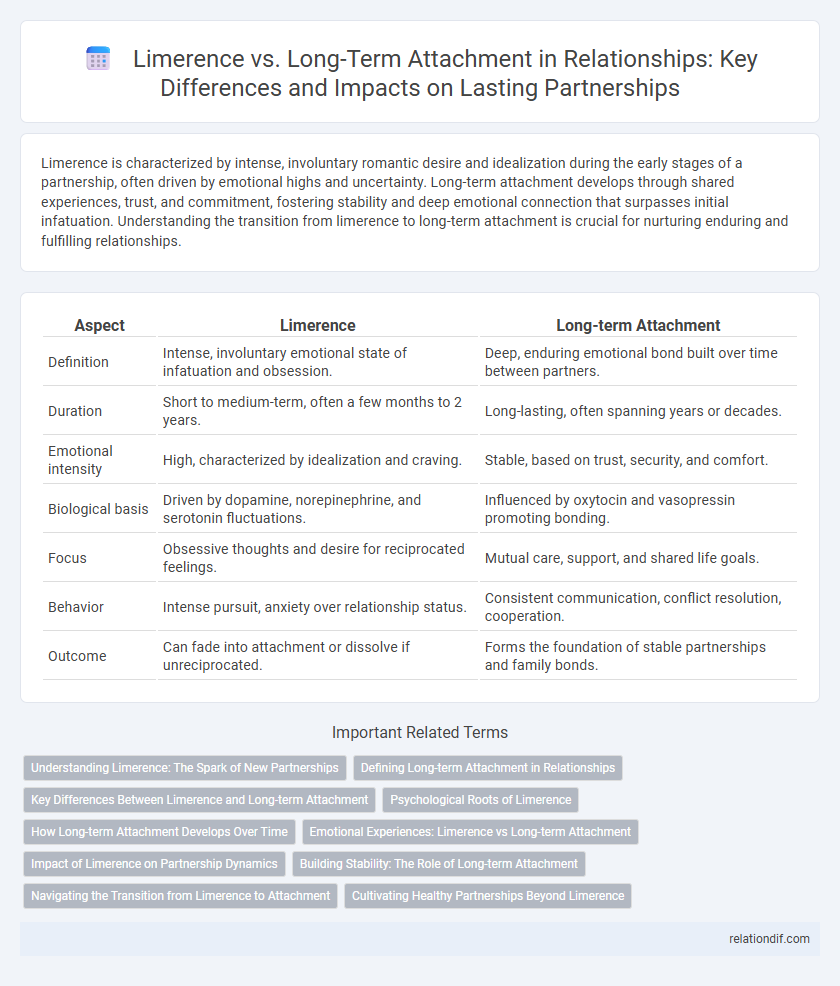Limerence is characterized by intense, involuntary romantic desire and idealization during the early stages of a partnership, often driven by emotional highs and uncertainty. Long-term attachment develops through shared experiences, trust, and commitment, fostering stability and deep emotional connection that surpasses initial infatuation. Understanding the transition from limerence to long-term attachment is crucial for nurturing enduring and fulfilling relationships.
Table of Comparison
| Aspect | Limerence | Long-term Attachment |
|---|---|---|
| Definition | Intense, involuntary emotional state of infatuation and obsession. | Deep, enduring emotional bond built over time between partners. |
| Duration | Short to medium-term, often a few months to 2 years. | Long-lasting, often spanning years or decades. |
| Emotional intensity | High, characterized by idealization and craving. | Stable, based on trust, security, and comfort. |
| Biological basis | Driven by dopamine, norepinephrine, and serotonin fluctuations. | Influenced by oxytocin and vasopressin promoting bonding. |
| Focus | Obsessive thoughts and desire for reciprocated feelings. | Mutual care, support, and shared life goals. |
| Behavior | Intense pursuit, anxiety over relationship status. | Consistent communication, conflict resolution, cooperation. |
| Outcome | Can fade into attachment or dissolve if unreciprocated. | Forms the foundation of stable partnerships and family bonds. |
Understanding Limerence: The Spark of New Partnerships
Limerence ignites the initial thrill in new partnerships through intense emotional and physical attraction, often characterized by idealization and obsessive thoughts about the partner. This phase activates dopamine and norepinephrine in the brain, creating a euphoric sense of connection and urgency to deepen the bond. Understanding limerence helps partners recognize its temporary nature, distinguishing it from long-term attachment rooted in trust, security, and mutual commitment.
Defining Long-term Attachment in Relationships
Long-term attachment in relationships is characterized by deep emotional bonds that develop through sustained trust, mutual support, and shared experiences over time. Unlike limerence, which involves intense, often short-lived infatuation and idealization, long-term attachment is grounded in stability, commitment, and emotional intimacy. Neuroscientific studies show that long-term attachment activates brain regions associated with reward and bonding, such as the ventral pallidum, highlighting its role in enduring romantic partnerships.
Key Differences Between Limerence and Long-term Attachment
Limerence is characterized by intense, involuntary romantic desire marked by obsessive thoughts and emotional highs, while long-term attachment involves stable, enduring bonds rooted in trust, commitment, and mutual support. Neurochemically, limerence is driven primarily by dopamine and norepinephrine surges, whereas long-term attachment engages oxytocin and vasopressin pathways that promote bonding and security. The volatility of limerence contrasts with the calm persistence of long-term attachment, highlighting their distinct roles in relationship dynamics and emotional development.
Psychological Roots of Limerence
Limerence is characterized by intense, obsessive thoughts and emotional dependence on a partner, rooted in dopamine-driven reward pathways and cognitive biases towards idealization. Unlike long-term attachment, which stems from oxytocin-mediated bonding and secure emotional connection, limerence arises from psychological mechanisms involving uncertainty and desire for reciprocation, often linked to early attachment styles and unmet emotional needs. Understanding the neurochemical and cognitive foundations of limerence helps differentiate it from stable relational bonds essential for lasting partnerships.
How Long-term Attachment Develops Over Time
Long-term attachment develops through consistent emotional support, shared experiences, and mutual trust, which deepen the bond beyond initial infatuation such as limerence. This attachment involves the release of bonding hormones like oxytocin and vasopressin, reinforcing a secure and stable connection over time. Building long-term attachment requires patience, effective communication, and commitment, enabling partners to navigate challenges and grow stronger together.
Emotional Experiences: Limerence vs Long-term Attachment
Limerence is characterized by intense emotional arousal, obsessive thoughts, and a desire for reciprocation, often triggering dopamine and adrenaline surges that create euphoric experiences. Long-term attachment involves deep emotional bonding, stability, and mutual trust, supported by oxytocin and vasopressin, which promote security and sustained connection. Emotional experiences in limerence are transient and idealized, whereas in long-term attachment they evolve into resilience and shared intimacy over time.
Impact of Limerence on Partnership Dynamics
Limerence generates intense emotional and physical attraction, often leading to idealized perceptions of a partner that can disrupt realistic communication and trust within the relationship. This heightened state of infatuation typically fades, causing potential instability and emotional volatility when partners transition towards long-term attachment. Understanding limerence's influence on early relationship dynamics is crucial for cultivating sustainable emotional bonds and fostering resilience in partnership growth.
Building Stability: The Role of Long-term Attachment
Long-term attachment fosters emotional security and resilience, crucial for building stability in partnerships by promoting trust and consistent support. Unlike limerence, which is characterized by intense but fleeting infatuation, long-term attachment enables couples to navigate challenges and maintain deep connection over time. Neuroscientific studies reveal that oxytocin and vasopressin play central roles in reinforcing these enduring emotional bonds.
Navigating the Transition from Limerence to Attachment
Navigating the transition from limerence--a state of intense romantic infatuation characterized by obsessive thoughts and idealization--to long-term attachment requires cultivating emotional intimacy, trust, and mutual respect. Understanding the neurobiological shift from dopamine-driven excitement to oxytocin-supported bonding helps partners prioritize stability and realistic expectations. Successful partnership growth depends on embracing vulnerability and consistent communication to deepen connection beyond initial limerence.
Cultivating Healthy Partnerships Beyond Limerence
Limerence, characterized by intense emotional arousal and idealization, often fuels the initial stages of partnership but tends to fade as reality sets in. Cultivating healthy long-term attachment involves developing mutual trust, consistent communication, and emotional regulation, which provide a stable foundation beyond the transient highs of limerence. Prioritizing secure attachment patterns over infatuation ensures resilience and deeper connection in enduring partnerships.
Limerence vs Long-term attachment Infographic

 relationdif.com
relationdif.com